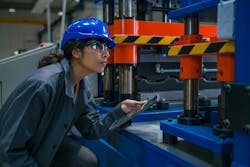Machine Safety Best Practices for High-Risk Industrial Automation
Industrial manufacturing environments have inherent risks that require vigilant machine safety measures to ensure personnel safety while protecting businesses from potential insurance increases or lawsuits due to injuries. For example, mechanical breakdowns, electrical failures and human errors can all lead to hazardous situations, which are magnified in high-risk environments.
To mitigate these risks, it’s essential to start with a thorough risk assessment by an experienced machine safety expert who is well-versed in specific industry and technological needs. Identifying potential hazards — whether from moving parts, electrical faults or unpredictable human interactions — is the first step toward safety. Once these risks are understood, companies can implement strategies like redundancy and fail-safe systems to minimize danger.
With this approach, even if one part of the system fails, the entire operation doesn’t grind to a halt or put anyone at risk.
Key machine safety risks to consider in a risk assessment include:
- Mechanical hazards: Moving parts that can injure workers.
- Electrical hazards: Short circuits or power surges that could cause fires or electrical shock.
- Chemical hazards: Exposure to toxic substances, fumes or spills.
- Human errors: Accidental activation or mis-operation of equipment.
- Environmental risks: High temperatures, humidity or other factors that impact equipment performance.
Best practices for implementing machine safety protocols
Safety doesn’t come from a single piece of equipment or a simple checklist. It requires an integrated approach considering the entire system and specific industry needs. Designing safety protocols should begin with modular systems that can be scaled as operations evolve. This ensures flexibility while maintaining strong safety measures.
Real-time monitoring is another key practice. Using sensors to track machinery health allows companies to catch potential issues before they lead to failure. Predictive maintenance becomes possible when systems flag early warning signs, allowing repairs to happen during scheduled downtime rather than during an emergency.
Redundancy is critical in these environments. For instance, using dual programmable logic controllers (PLCs) means that if the primary controller fails, a backup immediately takes over, ensuring continuous operations. Backup power supplies are also essential to keep systems running smoothly in case of outages.
How automation technology providers and controls engineers can enhance safety
Safety control devices such as safety PLCs, sensors and other safety components play a vital role in creating a secure and efficient industrial environment. These devices are not only equipped with advanced safety functions but are also certified to meet stringent safety integrity levels (SIL) and performance levels (PL) by third-party certification bodies, ensuring their reliability and compliance with international safety standards.
Here’s a closer look at the benefits and features that make these safety components essential:
Certification to safety standards. Safety PLCs and related control devices are certified by independent organizations to meet specific SIL and PL ratings, as defined by standards like IEC 61508 and ISO 13849. These certifications confirm that the devices have been rigorously tested for their ability to perform critical safety functions with a high degree of reliability. Such third-party validation guarantees that these components meet the necessary safety benchmarks required for industrial applications.
Advanced safety features:
- Pulse testing: This function ensures that safety circuits and sensors are periodically checked for integrity and functionality. Pulse testing detects potential faults such as wire breaks or short circuits, allowing for immediate corrective action to maintain safe operation.
- Dual channels: Safety control devices often use dual-channel configurations to ensure redundancy. This setup means that two independent circuits monitor the same safety function, so if one channel fails, the other can still maintain safety operations, significantly reducing the risk of a hazardous event.
- Redundancy and diversity: By incorporating redundancy (multiple backup systems) and diversity (different technologies or methods), safety components ensure that there are multiple layers of protection. This strategy is crucial for preventing failures caused by common mode errors and enhances overall system reliability.
- Fail-safe mechanisms: Safety PLCs are designed with built-in fail-safe features that automatically trigger an emergency stop or shutdown in the event of a critical issue. This proactive approach minimizes potential harm to both operators and equipment.
Proper integration by experts. While the components themselves are highly capable, their effectiveness relies on proper integration by experienced control engineers with machine safety expertise. These professionals ensure that safety components, such as PLCs, sensors and control devices are correctly implemented within the control system architecture. This ensures that pulse testing, dual channels, redundancy and other safety functions are embedded into the machinery’s operations, making safety an intrinsic part of the process rather than an afterthought.
Certifications drive reliability and trust. Using SIL- and PL-certified safety components provides confidence that the safety systems will perform as required, even in the most demanding conditions. The certification process includes thorough assessment and stress testing to verify that features like redundancy, diversity and fault diagnostics meet or exceed safety requirements.
Joe Carson is president and founder of Pacific Blue Engineering, an integrator member of the Control System Integrators Association (CSIA). For more information about Pacific Blue Engineering, visit its profile on the CSIA Industrial Automation Exchange.


